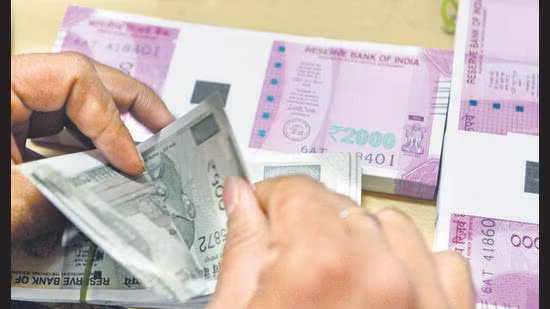- Courses
- GS Full Course 1 Year
- GS Full Course 2 Year
- GS Full Course 3 Year
- GS Full Course Till Selection
- Answer Alpha: Mains 2025 Mentorship
- MEP (Mains Enrichment Programme) Data, Facts
- Essay Target – 150+ Marks
- Online Program
- GS Recorded Course
- Polity
- Geography
- Economy
- Ancient, Medieval and Art & Culture AMAC
- Modern India, Post Independence & World History
- Environment
- Governance
- Science & Technology
- International Relations and Internal Security
- Disaster Management
- Ethics
- NCERT Current Affairs
- Indian Society and Social Issue
- NCERT- Science and Technology
- NCERT - Geography
- NCERT - Ancient History
- NCERT- World History
- NCERT Modern History
- CSAT
- 5 LAYERED ARJUNA Mentorship
- Public Administration Optional
- ABOUT US
- OUR TOPPERS
- TEST SERIES
- FREE STUDY MATERIAL
- VIDEOS
- CONTACT US
EXCHANGE RATE MANAGEMENT IN INDIA
EXCHANGE RATE MANAGEMENT IN INDIA
19-12-2023
Context
- The Indian rupee’s value against major trading currencies has reached a near 2 year high, influenced by central bank intervention and high domestic inflation.
Currency Valuation
- Definition: Determining the worth of one currency in terms of another.
- Influencing Factors: Interest rates, inflation, capital flow, money supply.
- Common Method: Using exchange rates (e.g., USD to INR exchange rate).
Exchange Rate Determination Methods
- Fixed Exchange Rates: Pegged (The term pegging refers to the practice of attaching or tying a currency's exchange rate to another country's currency.) to another currency, currency basket, or commodity like gold. Central banks actively maintain the rate.
- Flexible Exchange Rates: Determined by market forces (demand and supply). Central bank does not directly intervene.
- Managed Exchange Rates: Primarily market driven but with occasional central bank intervention to stabilize or influence rates.
Global Initiatives for Debt Crisis in Developing Countries
- IMF's Role: Addressing financing needs to prevent or resolve debt crises.
- Global Sovereign Debt Roundtable (GSDR): Launched by IMF, World Bank, and India during G-20 presidency to discuss sovereign debt restructuring.
- UNCTAD's DMFAS Programme: Enhancing government's debt management capability.
- Heavily Indebted Poor Countries (HIPC) Initiative: IMF and World Bank initiative to manage debt burdens in poor countries.
Exchange Rate Determination in India
- Since 1993, methods have evolved to reflect market dynamics, currently using NEER and REER evaluations. (Prelims)
Effects of Exchange Rate on Key Economic Variables
- Inflation: Currency valuation impacts the cost of imported goods.
- Interest Rates: Central banks adjust rates in response to currency strength.
- Economic Growth: Strong currency might reduce export driven growth.
- Trade: Trade balances are influenced by currency strength.
- Capital Flow: Currency strength can attract foreign investment.
- Business Decisions: Exchange rate volatility affects business planning.
Challenges in Managing Exchange Rates
- Geopolitical Events: Can cause unpredictable rate movements.
- Speculation and Manipulation: Affects forex market stability.
- Government Intervention: May impact market perceptions.
- Impossible Trinity: Balancing independent monetary policy, fixed exchange rate, and free capital flow.
Solutions
- International Policy Coordination: Through bodies like the Bank of International Settlements.
- Maintaining Foreign Exchange Buffers: To manage market volatility.
- Advocacy Against Currency Manipulation: Addressing manipulation concerns at international forums.



